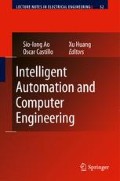Abstract
Integration of deliberation and reaction has been an important research topic concerning agents in view of the need for an agent to react tentatively and immediately to the changing world when unexpected events occur while executing a plan. An agent is not supposed to think for a long time before reacting. Also, its reaction is not supposed to change the world greatly. However, there are some cases where deliberation is necessary for achieving an emergency goal or where the emergency plan execution prevents the resumption of the suspended plan execution. This chapter presents a new concept of on-line interruption planning that integrates deliberation and emergency deliberation. When an emergency goal is given while executing a plan, our agents suspend the current plan execution, make and execute an emergency plan, and resume the suspended plan execution. Because our agents continuously modify the suspended plans while executing an emergency plan, they can resume the suspended plans correctly and efficiently even if the world has changed greatly due to the emergency plan execution.
Access this chapter
Tax calculation will be finalised at checkout
Purchases are for personal use only
References
Braubach, L., Pokahr, A., & Lamersdorf, W. (2005). Jadex: A BDI-agent system combining middleware and reasoning. In Software agent-based applications, platforms and development kits (pp. 143–168). Birkha̋user Book.
Brooks, R. (1986). A robust layered control system for a mobile robot. IEEE Journal of Robotics and Automation, 2(1), 14–23.
Currie, K., & Tate, A. (1991). O-plan: The open planning architecture. Artificial Intelligence, 52(1), 49–86.
Dastani, M., van Riemsdijk, B., Dignum, F., & Meyer, J-J. (2003). A programming language for cognitive agents: Goal directed 3APL. Proceedings of international workshop on programming multiagent systemslanguages, frameworks, techniques and tools (ProMAS03) (pp. 111–130).
desJardins, M., Durfee, E., Ortiz, C., & Wolverton, M. (1999). A survey of research in distributed, continual planning. AI Magazine, 20(4), 13–22.
Georgeff, M., & Ingrand, F. (1989). Decision-making in an embedded reasoning system. In Proceedings of the international joint conference on artificial intelligence (IJCAI89) (pp. 972–978).
Haigh, K., & Veloso, M. (1998). Interleaving planning and robot execution for asynchronous user requests. Autonomous Robots, 5(1), 79–95.
Hayashi, H., Tokura, S., Hasegawa, T., & Ozaki, F. (2006). Dynagent: An incremental forward-chaining HTN planning agent in dynamic domains. In The post-proceedings of the international workshop on declarative agent languages and technologies (DALT05), LNAI 3904 (pp. 171–187). Springer, Germany.
Hayashi, H., Tokura, S., & Ozaki, F. (2009). Towards real-world HTN planning agents, volume 170 of Studies in Computational Intelligence, Chapter 2 (pp. 13–41). Springer, Germany.
Howden, N., Rőnnquist, R., Hodgson, A., & Lucas, A. (2001). JACK: Intelligent agents – summary of an agent infrastructure. In Proceedings of the international workshop on infrastructure for agents, MAS, and scalable MAS (IAMSMAS01).
Kowalski, R., & Sadri, F. (1999). From logic programming towards multi-agent systems. Annals of Mathematics and Artificial Intelligence, 25, 391–419.
Morley, D., & Myers, K. (2004). The SPARK agent framework. In the international joint conference on autonomous agents and multi-agent systems (AAMAS04) (pp. 712–719).
Nau, D., Cao, Y., Lotem, A., and Mũnoz-Avila, H. (1999). SHOP: simple hierarchical ordered planner. In the proceedings of the international joint conference on artificial intelligence (IJCAI99) (pp. 968–975).
Rao, A. (1996). AgentSpeak(L): BDI agents speak out in a logical computable language. In the European workshop on modelling autonomous agents in a multi-agent world (MAAMAW96) (pp. 42–55).
Sacerdoti, E. (1977). A Structure for plans and behavior. American Elsevier, USA.
Tate, A. (1977). Generating project networks. In Proceedings of the international joint conference on artificial intelligence (IJCAI77) (pp. 888–893).
Wilkins, D. (1988). Practical planning. San Mateo, CA: Morgan Kaufmann.
Wilkins, D., & desJardins, M. (2001). A call for knowledge-based planning. AI Magazine, 22(1), 99–115.
Yan, S.-B., Lin, Z.-N., Hsu, H.-J., & Wang, F.-J. (2005). Intention scheduling for BDI agent systems. In Proceedings of the annual international computer software and applications conference (COMPSAC05) (pp. 133–140).
Author information
Authors and Affiliations
Corresponding author
Editor information
Editors and Affiliations
Rights and permissions
Copyright information
© 2009 Springer Science+Business Media B.V.
About this chapter
Cite this chapter
Hayashi, H., Tokura, S., Ozaki, F., Hasegawa, T. (2009). Emergency HTN Planning. In: Huang, X., Ao, SI., Castillo, O. (eds) Intelligent Automation and Computer Engineering. Lecture Notes in Electrical Engineering, vol 52. Springer, Dordrecht. https://doi.org/10.1007/978-90-481-3517-2_3
Download citation
DOI: https://doi.org/10.1007/978-90-481-3517-2_3
Published:
Publisher Name: Springer, Dordrecht
Print ISBN: 978-90-481-3516-5
Online ISBN: 978-90-481-3517-2
eBook Packages: EngineeringEngineering (R0)

